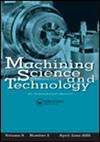基于稳定区域图(SRD)的Ti-6Al-4V薄壁表面无颤振铣削策略研究
IF 2.6
4区 工程技术
Q2 ENGINEERING, MANUFACTURING
引用次数: 0
摘要
摘要随着工件柔性的增加,加工稳定性预测中的不确定性也随之增加。过去的研究表明,由于零件的高灵活性,即使使用稳定性图中最大的口袋,也无法稳定该过程。因此,目前的研究强调广泛的实验分析,其中揭示了稳定性谱图的不确定性,特别是在柔性零件加工的情况下。这导致在目前的研究中引入了一个新的术语“稳定区域图(SRD)”。实验分析了低刚度Ti-6Al-V4薄壁件无颤振加工的三种广义加工方案。这些包括场景1,工件具有相同的加工前刚度和加工期间和加工后的固有频率。在场景ii中,工件刚度和固有频率最初不同,但加工后相同。在场景iii中,工件具有相同的加工前刚度和固有频率,但在加工过程中和加工后在中间1/3部分上发生变化,跨越在凸台之间。利用稳定区域图(SRD)开发了切削速度-进给-径向切削深度最佳组合的各种加工策略,以实现沿柔性工件表面整个切削长度的稳定加工。对于场景i和II,在切割宽度小于或等于工件的最终厚度时,稳定的加工是可能的,并且在整个工件长度上恒定的主轴转速为4,000 rpm。然而,当切削宽度大于加工后工件的厚度时,使用主轴速度提升技术可以实现稳定的加工。在场景iii中,发现周围未切削的材料使加工不稳定,可以通过主轴转速下降技术来改善。本文章由计算机程序翻译,如有差异,请以英文原文为准。
Strategy development for chatter-free milling of Ti-6Al-4V thin-walled surfaces using stability region diagram (SRD)
Abstract The uncertainty in the prediction of machining stability increases with the increasing flexibility of the workpiece. The past research showed that the process cannot be stabilized even using the largest pockets in the stability diagrams due to high flexibility of the parts. Therefore, the present research emphasizes extensive experimental analysis where the uncertainty of the stability lobe diagrams was brought into the light, especially in the case of machining of flexible parts. This led to the introduction of a new term “Stability Region Diagram (SRD)” in the present research. The three generalized machining scenarios for chatter-free machining of thin-walled features on low rigidity Ti-6Al-V4 were experimentally analyzed. These include Scenario-I, where workpieces have identical pre-machining stiffness and natural frequency that varies during and after machining. In Scenario-II, workpiece stiffness and natural frequencies vary initially but are identical after machining. In Scenario-III, workpieces have identical pre-machining stiffness and natural frequency but vary during and after machining over central 1/3 part, straddled between bosses. Various machining strategies with an optimum combination of cutting speed-feed-radial depth of cut were developed using stability region diagrams (SRD) to achieve stable machining throughout the length of the cut along the flexible workpiece surface. For Scenario-I and II, stable machining is possible at widths of cut lesser than or equal to the final thickness of workpiece and at a constant spindle speed of 4,000 rpm throughout the length of the workpiece. However, while machining at widths of cut more than the post-machining thickness of the workpiece, the stable machining is possible using a spindle speed ramp-up technique. In the Scenario-III, the surrounding uncut material is found to make machining unstable which can be improved by spindle speed ramp-down technique.
求助全文
通过发布文献求助,成功后即可免费获取论文全文。
去求助
来源期刊

Machining Science and Technology
工程技术-材料科学:综合
CiteScore
5.70
自引率
3.70%
发文量
18
审稿时长
6 months
期刊介绍:
Machining Science and Technology publishes original scientific and technical papers and review articles on topics related to traditional and nontraditional machining processes performed on all materials—metals and advanced alloys, polymers, ceramics, composites, and biomaterials.
Topics covered include:
-machining performance of all materials, including lightweight materials-
coated and special cutting tools: design and machining performance evaluation-
predictive models for machining performance and optimization, including machining dynamics-
measurement and analysis of machined surfaces-
sustainable machining: dry, near-dry, or Minimum Quantity Lubrication (MQL) and cryogenic machining processes
precision and micro/nano machining-
design and implementation of in-process sensors for monitoring and control of machining performance-
surface integrity in machining processes, including detection and characterization of machining damage-
new and advanced abrasive machining processes: design and performance analysis-
cutting fluids and special coolants/lubricants-
nontraditional and hybrid machining processes, including EDM, ECM, laser and plasma-assisted machining, waterjet and abrasive waterjet machining
 求助内容:
求助内容: 应助结果提醒方式:
应助结果提醒方式:


